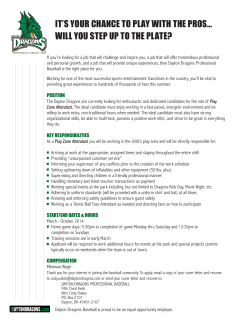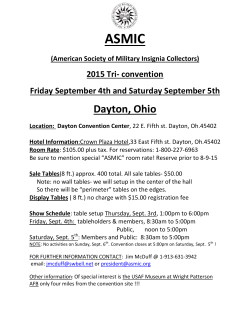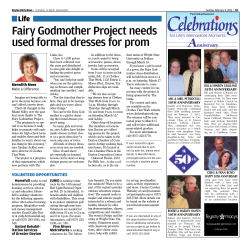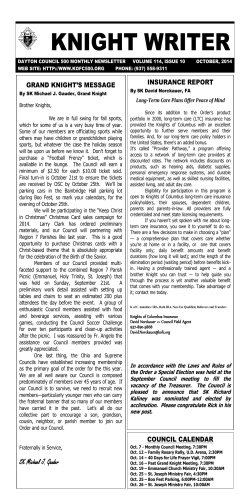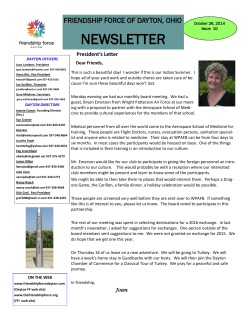
SCIENCE/TECHNOLOGY & INVENTION FAIR STUDENT SUPPORT PACKET District
District SCIENCE/TECHNOLOGY & INVENTION FAIR STUDENT SUPPORT PACKET District Science Fair Saturday February 7, 2015 ♦ ♦ ♦ ♦ ♦ ♦ ♦ ♦ ♦ ♦ General Information What is “not allowed” and “allowed” (ISEF) International Science Engineering Fair Categories Project Display Written Report Outline Oral Presentation Outline Science Project Checklist Display Board Headers Sample Abstracts Science Project Completion Schedule STUDENT’S NAME: _______________________________________________________ SCIENCE FAIR PROJECT EXPECTATIONS General Information A. All projects must follow the scientific method. B. Projects should have a type-written or computer printed report. C. Projects should include a journal, which logs events of project from beginning to the end. D. Models (i.e., Solar System, etc.) and demonstrations will not be accepted. E. Team projects should include each team member’s name on report, abstract, journal and display board. F. Project topics that are not acceptable: 1. Tornadoes 2. Volcanoes 3. Egg and Vinegar 4. Electromagnets 5. Dancing Raisins PROJECT DISPLAYS A. Make sure the display reflects the current year’s work only. B. All printed items should be typed or computer printed. C. Use Word or computer printed type programs if possible. D. A good title is extremely important as an attention grabber. It should simply and accurately represent your research. E. Take photographs of important phases or parts of your experiment. F. Be organized so that your display is logically presented and easy to read. G. Check the following for accuracy: 1. Spelling 3. Adhere to size limitations 2. Content 4. Safety rules are followed H. Use neat, colorful headings, charts, and graphs to present your project. (i.e., charts, graphs, tables, pictures, etc.) 2 Mission Statement Dayton Public Schools provides a high-quality education in a safe environment that prepares our students for success in school, work and life by providing a highly effective trained staff working each day with community resources. I. Not allowed at project or in booth: 1. 2. 3. 4. 5. 6. 7. 8. 9. 10. 11. 12. 13. 14. 15. 16. 17. 18. Living organisms, including plants Taxidermy specimens or parts Preserved vertebrate or invertebrate animals Human or animal food Human/animal parts or body fluids (for example, blood, urine) Plant materials (living, dead, or preserved) that are in their raw, unprocessed, or non-manufactured state (Exception: manufactured construction materials used in building the project or display) All chemicals including water (Exceptions: water integral to an enclosed, sealed apparatus.) All hazardous substances or devices [for example, poisons, drugs, firearms, weapons, ammunition, reloading devices, and lasers (as indicated in item 5 in the section of these rules entitled “Allowed at Project or in Booth BUT with the Restrictions Indicated”)] Dry ice or other sublimating solids Sharp items (for example, syringes, needles, pipettes, knives) Flames or highly flammable materials Batteries with open-top cells Awards, medals, business cards, flags, logos, endorsements, and/or acknowledgments (graphic or written) unless the item(s) are an integral part of the project (Exception: Intel ISEF medal(s) may be worn at all times.) Photographs or other visual presentations depicting vertebrate animals in surgical techniques, dissections, necropsies, or other lab procedures Active Internet or e-mail connections as part of displaying or operating the project at the Intel ISEF Prior years’ written material or visual depictions on the vertical display board. [Exception: the project title displayed in the Finalist’s booth may mention years or which year the project is (for example, “Year Two of an Ongoing Study”)]. Continuation projects must have the Continuation Project Form (7) vertically displayed. Glass or glass objects unless deemed by the Display and Safety Committee to be an integral and necessary part of the project (Exception: glass that is an integral part of a commercial product such as a computer screen) Any apparatus deemed unsafe by the Scientific Review Committee, the Display and Safety Committee, or Society for Science & the Public (for example, large vacuum tubes or dangerous ray-generating devices, empty tanks that previously contained combustible liquids or gases, pressurized tanks, etc.) 3 Mission Statement Dayton Public Schools provides a high-quality education in a safe environment that prepares our students for success in school, work and life by providing a highly effective trained staff working each day with community resources. Allowed at project or in booth BUT with the RESTRICTIONS indicated: J. 1. Soil, sand, rock, and/or waste samples if permanently encased in a slab of acrylic 2. Postal addresses, World Wide Web and e-mail addresses, telephone and fax numbers of Finalist only 3. Photographs and/or visual depictions if: a. They are not deemed offensive or inappropriate by the Scientific Review Committee, the Display and Safety Committee, or Society for Science & the Public. This includes, but is not limited to, visually offensive photographs or visual depictions of invertebrate or vertebrate animals, including humans. The decision by any one of the groups mentioned above is final. b. They have credit lines of origin (“Photograph taken by...” or “Image taken from...”). (If all photographs being displayed were taken by the Finalist or are from the same source, one credit line prominently and vertically displayed is sufficient.) c. They are from the Internet, magazines, newspapers, journals, etc., and credit lines are attached. (If all photographs/images are from the same source, one credit prominently and vertically displayed is sufficient.) d. They are photographs or visual depictions of the Finalist. e. They are photographs of human subjects for which signed consent forms are at the project or in the booth. 4. Any apparatus with unshielded belts, pulleys, chains, or moving parts with tension or pinch points if for display only and not operated. 5. Class II lasers if: a. The output energy is <1 mW and is operated only by the Finalist b. Operated only during the Display and Safety inspection and during judging c. Labeled with a sign reading “Laser Radiation: Do Not Look into Beam” d. Enclosed in protective housing that prevents physical and visual access to beam e. Disconnected when not operating Note: Class II lasers are found in laser pointers and in aiming and range-finding devices. They pose a risk if the beam is directly viewed over a long period of time. 6. Class III and IV lasers if for display only and not operated (See the description of Class III and Class IV lasers in the Radiation section of the Hazardous Chemicals, Activities, or Devices, p. 27 of The International Rules and Guidelines. 7. Any apparatus producing temperatures that will cause physical burns if adequately insulated 8. The only items that may be displayed on the front of the provided tables are the forms listed in the section of these rules entitled “Required to be Visible and Vertically Displayed at the Intel ISEF” 4 Mission Statement Dayton Public Schools provides a high-quality education in a safe environment that prepares our students for success in school, work and life by providing a highly effective trained staff working each day with community resources. ISEF CATEGORY DESCRIPTIONS PRE SCHOOL THROUGH GRADES 12 1) Behavioral and Social Sciences Human and animal behavior, social and community relationships — psychology, sociology, anthropology, archaeology, ethology, ethnology, linguistics, learning, perception, urban problems, reading problems, public opinion surveys, educational testing, etc. 2) Biochemistry Chemistry of life processes — molecular biology, molecular genetics, enzymes, photosynthesis, blood chemistry, protein chemistry, food chemistry, hormones, etc. 3) Botany Study of plant life — agriculture, agronomy, horticulture, forestry, plant taxonomy, plant physiology, plant pathology, plant genetics, hydroponics, algae, etc. 4) Chemistry Study of nature and composition of matter and laws governing it — physical chemistry, organic chemistry (other than biochemistry), inorganic chemistry, materials, plastics, fuels, pesticides, metallurgy, soil chemistry, etc. 5) Computer Science Study and development of computer software and hardware and associated logical devices. 6) Earth and Space Sciences Geology, mineralogy, physiography, oceanography, meteorology, climatology, astronomy, geology, speleology, seismology, geography, 7) Engineering Technology projects that directly apply scientific principles to manufacturing and practical uses — civil, mechanical, aeronautical, chemical, electrical, photographic, sound, automotive, marine, heating and refrigeration, transportation, environmental engineering, etc. 8) Environmental Sciences Study of pollution (air, water, and land) sources and their control; ecology. 9) Gerontology Study of the aging process in living organisms. 10) Mathematics Development of formal logical systems or various numerical and algebraic computations, and the application of these principles — calculus, geometry, abstract algebra, number theory, statistics, complex analysis, probability. 11) Medicine and Health Study of diseases and health of humans and animals — dentistry, pharmacology, pathology, ophthalmology, nutrition, sanitation, pediatrics, dermatology, allergies, speech and hearing, etc. 12) Microbiology Biology of microorganisms — bacteriology, virology, protozoology, fungi, bacterial genetics, yeast, etc. 13) Physics Theories, principles, and laws governing energy and the effect of energy on matter — solid state, optics, acoustics, particle, nuclear, atomic, plasma, superconductivity, fluid and gas dynamics, thermodynamics, semiconductors, magnetism, quantum mechanics, biophysics, etc. 14) Zoology 5 Mission Statement Dayton Public Schools provides a high-quality education in a safe environment that prepares our students for success in school, work and life by providing a highly effective trained staff working each day with community resources. Study of animals — animal genetics, ornithology, ichthyology, herpetology, entomology, animal ecology, paleontology, cellular physiology, circadian rhythms, animal husbandry, cytology, histology, animal physiology, invertebrate neurophysiology, studies of invertebrates, etc. 6 Mission Statement Dayton Public Schools provides a high-quality education in a safe environment that prepares our students for success in school, work and life by providing a highly effective trained staff working each day with community resources. THE OHIO JUNIOR ACADEMY OF SCIENCE THE WRITTEN REPORT 1. General Instructions: Each project must include a written report covering in detail all of the work done, references consulted, and acknowledgements of assistance. The experimental data, statistics, notes, and computations should be recorded in logs or record books, but only the description of the work, the results, and the conclusions should be included in the report. This report should follow an accepted form of technical reporting and should be carefully checked for correctness of punctuation, spelling and grammar. Never copy a reference work unless such a quote is properly indicated, but every word of the quote must be understood. If possible the report should contain illustrations in the form of photographs, sketches, graphs. or charts, but only where they contribute to the effectiveness of the material presented. 2. Format and Suggestions: The following outline is suggested for the typical written report. 3. A. Title Page: Center the project title, and put your name, school, and grade at the bottom right. B. Table of Contents: Include a page number for the beginning of each section. C. Abstract: The abstract should be one page in length. You are required to write a maximum 250 word summary. The abstract should include the (a) purpose of the experiment, (b) procedures used, (c) data, and (d) conclusions. It may also include any possible research applications. The abstract should focus on work done since the last fair. D. Introduction: Prepare the reader for understanding the report by writing about the following: (1) Description of the problem (2) Historical background of the problem (3) Scope of the study and report E. Technical Discussion: Use a general narrative style to describe the project in some detail, progressing from the most important general ideas to the more detailed and specialized discussion. The technical discussion typically consists of the following: (1) Method: Describe what was done to solve the problem including the basic ideas and approach, experimental procedures and equipment, and data treatment. (2) Results: This section may include data (in tabular form with dates), calculated results, charts, graphs, illustrations. and photographs. (3) Discussion of Results: Give an explanation of the results obtained. Wherever possible, relate your experiment to similar material found in the literature. Discuss possible sources of error in your experiment. F. Conclusions and Recommendations: (1) State the general conclusions which the results of the study will support. (2) Describe (recommend) some additional work which could be done to improve the understanding of this problem or a related problem. G. Acknowledgements: Always credit those who assisted you, including individuals, businesses, and educational or research institutions. Identify any financial support or materials donations received, but do not put on display board. H. References: Your reference list should include any documentation that is not your own (i.e., books, journal articles). Example: Foley, J. D. (1987). Interfaces for Advanced Computing. “Scientific American,” 257: 127-135 Style Guide: More detailed suggestions for the written record and the oral presentation may be found in the Technical Writing Style Guide, which may be available from your school Library. 7 Mission Statement Dayton Public Schools provides a high-quality education in a safe environment that prepares our students for success in school, work and life by providing a highly effective trained staff working each day with community resources. THE OHIO JUNIOR ACADEMY OF SCIENCE ORAL PRESENTATION 1. General Instructions The participant must be prepared to give a clear and concise oral presentation of his project to the judges, to answer their questions, and to define any terms used. This oral presentation should be limited to a few (perhaps ten) minutes. If a question is not clear, ask the judge to rephrase it. If the answer to a question is not known, admit it. Do not attempt to recite a formal, memorized speech. 2. Suggestions A. Introduction The judges will introduce themselves. Be prepared to introduce yourself, your school, your grade, and the title of your project in a clear and positive manner. B. Content of the Oral Presentation Be prepared to describe your project to the judges. The content of your presentation should be based on your introduction and the technical discussion sections of your written report. End the presentation with a good statement of your experiment's conclusions and recommendations. C. Style of Delivery The way that you give your oral presentation (your "style") is important. Stand with good posture and look the judges in the eye occasionally. Use your visual aids effectively, and speak clearly to the judges. D. Question Period After your description of your project, the judges will usually carry the discussion further by asking questions and making suggestions. Be prepared to discuss your recommendations for further study. It is not expected that you can answer all the questions, but try to keep the discussion going in a positive way, while trying to learn from the judges. 8 Mission Statement Dayton Public Schools provides a high-quality education in a safe environment that prepares our students for success in school, work and life by providing a highly effective trained staff working each day with community resources. SCIENCE PROJECT CHECKLIST Ask a QUESTION/PROBLEM that you can investigate yourself. Begin a JOURNAL to write down everything you do, observe, and think during your investigation. Do RESEARCH on the TOPIC of your question. Form a HYPOTHESIS about what you think the answer to your question will be. Plan a PROCEDURE to TEST your hypothesis. Decide what MATERIALS you will need and write STEP-BY-STEP DIRECTIONS for what you will do and explaining how you will do it. Make sure you follow the rules for SCIENCE SAFETY and WORKING WITH ANIMALS. Construct a CHART to help you COLLECT and ORGANIZE your DATA. Fill out your SCIENCE PROJECT PROPOSAL and sign it. Then, have your teacher and your parents sign it too. Do this before you actually do the steps of your procedure. Follow the step-by-step directions of your procedure and RECORD your data onto your chart. Summarize the RESULTS of your testing in a WRITTEN SUMMARY. Make a GRAPH of the results, so others can see at a glance what you've learned. Write a CONCLUSION statement which either restates your hypothesis (if it is supported) or revises it (if it is not supported). Write a SCIENCE PROJECT REPORT that summarizes your investigation. Be prepared to give an ORAL PRESENTATION. Construct your SCIENCE PROJECT DISPLAY. Your teacher will complete a SCIENCE PROJECT EVALUATION. 9 Mission Statement Dayton Public Schools provides a high-quality education in a safe environment that prepares our students for success in school, work and life by providing a highly effective trained staff working each day with community resources. Suggested Display Board Headers: PROBLEM HYPOTHESIS PURPOSE PROCEDURE MATERIALS METHODS DISCUSSION 10 Mission Statement Dayton Public Schools provides a high-quality education in a safe environment that prepares our students for success in school, work and life by providing a highly effective trained staff working each day with community resources. DATA RESULTS ABSTRACT CONCLUSION NEXT STEPS 11 Mission Statement Dayton Public Schools provides a high-quality education in a safe environment that prepares our students for success in school, work and life by providing a highly effective trained staff working each day with community resources. PROJECT DISPLAY A typical display should have the following elements: Title Abstract Background information including objective, problem and hypothesis Experimental Design (Method and Materials) Results including tables and graphs of data Discussion/Conclusion(s) Technical Report Logbook, research plan and protocols/forms Photographs of equipment, samples or other items from your experiment (Display only photographs or drawings, not the actual equipment or samples) 12 Mission Statement Dayton Public Schools provides a high-quality education in a safe environment that prepares our students for success in school, work and life by providing a highly effective trained staff working each day with community resources. Items Allowed at Project with the Restrictions Indicated (District, Regional and State fairs) 1. Posters should display: a. An abstract, data tables, diagrams, charts, photographs and graphs that summarize results. 2. Research notebooks, research reports, research plans and documentation of research protocols are expected and may be in notebooks or folders on the table for use by science day officials and judges. 3. Information such as postal, web and e-mail addresses, telephone and fax numbers is allowed only for the exhibitor. 4. The only photographs or visual depictions of identifiable or recognizable people allowed are photographs of the exhibitor, photographs taken by the exhibitor (with permission of individuals received), or photographs for which credit is displayed (such as from magazines, newspapers, journals, etc.). 5. Battery-powered computers may be used only for simulation, modeling, animation or data display integral and essential to the project results and not for general PowerPoint™ presentations. 13 Mission Statement Dayton Public Schools provides a high-quality education in a safe environment that prepares our students for success in school, work and life by providing a highly effective trained staff working each day with community resources. MY ORAL PRESENTATION Use the following outline as a guide: My name is_________________________________________ I am in the grade at The title of my project is I became interested in doing this project when The QUESTION I asked was The HYPOTHESIS I formed was The PROCEDURE I used to test my hypothesis was to (Use as few words as possible.) I repeated this procedure times to make certain that my results were valid. The RESULTS were The results showed that my hypothesis was (supported or not supported) The CONCLUSION I reached was (if your hypothesis was supported, restate your hypothesis. If your hypothesis was not supported, state your revised hypothesis.) If I were to do this investigation again, I would (Write in something you might change, or do differently.) 14 Mission Statement Dayton Public Schools provides a high-quality education in a safe environment that prepares our students for success in school, work and life by providing a highly effective trained staff working each day with community resources. SAMPLE ABSTRACTS ASPIRIN: THE WONDER DRUG Nose, Mayumi 153 Fujita Road, San Vitores Tumon, Guam 96911 Academy of Our Lady of Guam, Agana, GU 96910 Many brand name aspirins are advertised on television to lure consumers into buying certain tablets. We buy various products such as Bufferin, Anacin, Exedrin. Alka Seltzer, Ecotrin, Dristan, Bayer, and Springfield. All these brand names claim that they contain a special ingredient that works better than the others. This experiment will test to see whether these brand names with outrageous prices are superior to the generic brands which are sold at a more reasonable cost. Additionally, this project is designed to explain the synthesis, decomposition, and the rate of disintegration of aspirin. However, this study will help educate the consumers to discern what the best is for them. LUMBRICUS TERRESTRIS: A STATISTICAL ANALYSIS OF DRUG REACTION Kellum, Kerrolyn Kelly P.O. Box 556, University, MS 38677 Lafayette High School, Oxford, MS 38655 The purpose of this project is to determine the effects of various concentrations of a stimulant and a depressant on the behavior of earthworms. The hypothesis states that there is no difference in the pre-treatment and post-treatment of the stimulant (Quick Charge) and the depressant (Calm & Easy). The "+" values were determined for the .01g/ml, the .001g/ml, .001g/ml application of the stimulant and depressant. Results indicated that there were statistically significant difference at the .01g/ml and .001g/ml stimulant concentration level and the .01g/ml depressant concentration level. Results indicate this project warrants further research for possible test of drug reactions. The conclusion is that there is a significant difference in the pre-treatment and the post-treatment. A NEW ROLE FOR HDL AS A SOURCE OF CHOLESTEROL FOR GROWING CELLS Thompson, Mark, Benj. 7413 Strathmore Drive, New Orleans, LA 70128 (504) 241-7168 Franklin Sr. High Sch., New Orlenas, LA 70119 In this experiment, HDL was tested to determine if it could provide cholesterol to a cell-line dependent on exogenous cholesterol. LDL had already been shown to promote cell growth, but the role of HDL in cell growth was unclear. Several sets of cell suspensions were cultured in media containing HDL, LDL, cholesterol, phosphaticly1chollne, linoleic acid or fetal calf serum. The number of cells grown in the cultures were counted daily and recorded. In terms of the total number of cells in the cell counts, fetal calk serum made the cells grow the best. The growth seen in the LDL cultures was several times smaller. The HDL culture cell counts were smaller than those of LDL. However, when comparing growth by percentage of change from the ratings on Day 1, HDL grew better than LDL. cholesterol, phosphatidylcholine and linoleic acid. this evidence suggests that HDL does provide cholesterol for cellular growth 15 Mission Statement Dayton Public Schools provides a high-quality education in a safe environment that prepares our students for success in school, work and life by providing a highly effective trained staff working each day with community resources. SCIENCE PROJECT COMPLETION SCHEDULE (Student’s Name)for Keep this schedule in a place where it is easily seen. ASSIGNMENT DATE DUE DATE COMPLETED Question Hypothesis Project Proposal Journal Report Project display Oral Presentation Evaluation 16 Mission Statement Dayton Public Schools provides a high-quality education in a safe environment that prepares our students for success in school, work and life by providing a highly effective trained staff working each day with community resources. NOTES 17 Mission Statement Dayton Public Schools provides a high-quality education in a safe environment that prepares our students for success in school, work and life by providing a highly effective trained staff working each day with community resources.
© Copyright 2025

